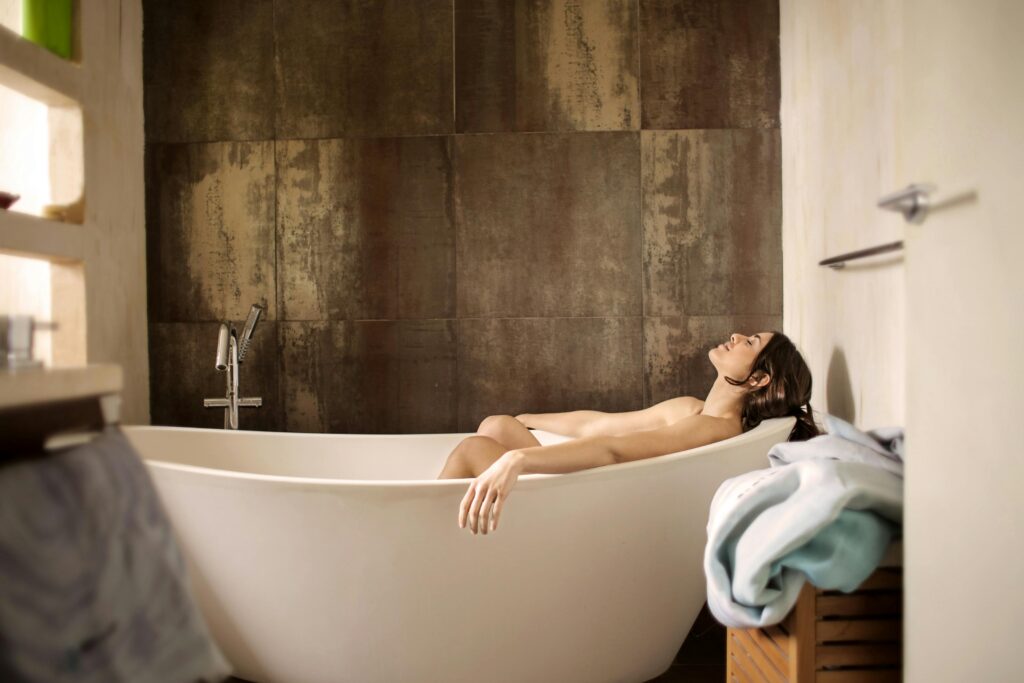The Ultimate Guide to Morning Bath Benefits: A Gentle Routine for Energy & Circulation
A refreshing morning bath can do more than wake you up — it detoxes your skin, improves mood, and sets a positive rhythm for your entire day. Understanding the true morning bath benefits helps you design a simple routine that balances warmth, circulation, and calm. Your skin eliminates massive amounts of waste through millions of pores, and when you encase your body in clothing daily, these pores need regular attention. Whether you prefer a full bath or a quick morning shower, the key lies in using strategic temperature changes to open these channels, stimulate blood flow, and prepare your body for optimal performance throughout the day.

Top 4 Morning Bath Benefits You Can Start Enjoying Today
Here are the Top 4 morning bath benefits you can start enjoying today:
- Opens pores and boosts detox through gentle perspiration: Warm water induces natural sweating that pushes impurities embedded deep within your skin to the surface. This process removes waste that regular washing simply cannot reach, leaving your skin genuinely clean and your pores functioning optimally.
- Stimulates circulation and relieves morning fatigue: Temperature changes force your blood vessels to expand and contract, which pumps fresh blood to your extremities and internal organs. Research shows that passive body heating improves vascular function and reduces blood pressure, helping you shake off morning sluggishness naturally.
- Promotes relaxation, improving mental clarity: The combination of warm water and controlled breathing activates your parasympathetic nervous system, reducing stress hormones while sharpening your mental focus. You’ll step out feeling centered and ready to tackle complex tasks.
- Strengthens immunity and skin vitality: Regular thermal therapy enhances your body’s natural defense mechanisms while improving skin elasticity and tone. Studies demonstrate that heat therapy supports cardiovascular health and metabolic function, building resilience from the inside out.
How Warm Morning Bath Benefits
Warm morning bath benefits extend far beyond simple relaxation. When you immerse yourself in warm water around 108°F, your body responds by dilating blood vessels near the skin’s surface, which enhances circulation throughout your system. This process encourages your pores to release trapped oils, dead skin cells, and environmental toxins that accumulate despite daily washing.
The gentle heat also relaxes tense muscles and prepares your body for the day’s physical demands. Your skin’s natural barrier function improves as warmth stimulates sebaceous glands to produce healthy oils. This physiological response explains why warm bathing has remained a cornerstone of wellness practices across cultures for millennia.
Read more about the body’s natural cleansing in our Curative Baths: Nature Healing Guide.
A hot water bath taken properly supports your lymphatic system’s ability to move cellular waste toward elimination pathways. The key lies in maintaining the water temperature high enough to induce light perspiration without causing discomfort or strain on your heart. Most people achieve optimal results when they stay immersed for 10-15 minutes, allowing their body temperature to rise gradually and naturally. Even if you’re short on time, a shower in morning hours using this warm-to-cold principle delivers similar benefits.
Cold Bath vs Hot Bath — Which is Better?
The cold bath vs hot bath debate misses a crucial point: each temperature serves distinct physiological purposes, and combining them strategically delivers superior results. Cold water exposure causes vasoconstriction, forcing blood toward your core organs and toning your circulatory system. This shock response activates your sympathetic nervous system, releasing adrenaline and heightening alertness.
Hot water creates the opposite effect through vasodilation, drawing blood to your skin’s surface and promoting relaxation. This temperature contrast training — alternating between hot and cold — forces your cardiovascular system to work dynamically, similar to interval training for your blood vessels.
However, the sequence matters tremendously. Starting with a hot water bath prepares your body with surplus heat, ensuring that when you switch to cold water, you achieve robust reaction without depleting vital energy. Research from the National Institutes of Health confirms that controlled temperature variation significantly improves circulation and cardiovascular responsiveness.
The strategic answer to cold bath vs hot bath is: use both, but warm first. This approach harnesses morning bath benefits from each temperature while protecting those with sensitive constitutions from excessive strain. Whether you’re taking a full bath or adjusting your morning shower, this temperature strategy remains essential.
Morning Bath for Better Circulation
A morning bath for better circulation works by leveraging your body’s natural thermal regulation responses. When you sit in warm water with your lower body immersed and upper body exposed to cooler air, you create a circulation gradient that pumps blood efficiently throughout your system. This technique avoids the fainting sensation some people experience when fully submerged in hot water, while still achieving substantial cardiovascular benefits.
The warm-to-cold method particularly benefits people who struggle with cold hands and feet. By building up body heat first, you ensure abundant warmth reserves when cold water touches your skin. Your body responds by powerfully pushing blood to your extremities, often eliminating chronic coldness that persists despite other warming attempts.
This circulatory boost connects directly to oxygen utilization. When blood moves more efficiently, it delivers oxygen and nutrients to tissues more effectively while removing metabolic waste. Discover how circulation connects to oxygen intake in our Fresh Air Benefits Guide.
How to Take a Safe Morning Bath (Hot → Cold Method)
Follow these steps to maximize morning shower and bath benefits while protecting your body from unnecessary strain:
- Warm the body with a brief hot water bath (about 108°F): Fill your tub deep enough to cover your legs and hips when seated. Ensure you have extra hot water available to maintain temperature, as the water cools during your bath. For a shower in morning routine, start with comfortably warm water for 8-10 minutes.
- Stay immersed 10-15 minutes to induce light perspiration: Sit upright with your upper body exposed to room air. This position prevents excessive strain on your heart while allowing perspiration to begin. You’ll notice beads forming on your forehead and upper body. If using a morning shower, let warm water run over your body until you feel light sweating begin.
- Apply soap, rinse, then quickly switch to cool or cold water for 30-60 seconds: Once you’ve thoroughly washed and perspiration flows freely, stand in the warm water and sponge your entire body with cold water from a basin. For a shower in morning, simply turn the temperature to cool or cold for the final 30-60 seconds. Adjust the duration based on your comfort and how vigorously your skin responds.
- Dry briskly and relax for 5 minutes before dressing: Towel off with energetic rubbing motions to stimulate surface circulation further. Allow your body to stabilize before putting on clothes, ensuring complete reaction has occurred.

This method aligns with therapeutic research on passive heating and delivers comprehensive benefits safely, whether you prefer a full bath or quick morning shower.
Morning Bath for Sensitive Skin
A morning bath for sensitive skin requires gentle temperature control rather than extreme heat. Skin that reacts to harsh soaps, fragrances, or temperature fluctuations benefits enormously from the perspiration-based cleansing that warm water provides. When you induce natural sweating, your pores release impurities without requiring aggressive scrubbing or chemical products.
The key is maintaining water temperature around 105-108°F — warm enough to open pores but not so hot that it triggers inflammation or excessive dryness. This moderate hot water bath approach allows sensitive skin to purify itself through its natural mechanisms rather than through external irritation.
Your routine for sensitive skin should emphasize the perspiration phase over extended soaking. Ten minutes of warm immersion typically suffices to achieve thorough pore opening and cleansing. The brief cold rinse that follows tones skin without causing the redness or irritation that prolonged cold exposure might trigger.
People with conditions such as eczema or rosacea frequently find that this gentle, temperature-controlled bathing method outperforms typical showering—because it works with the skin’s barrier rather than against it, much like how dermatologists recommend mild cleansing in rosacea management to avoid irritation and preserve skin integrity. The benefits for sensitive skin include reduced inflammation, fewer breakouts, and improved moisture retention.
Is a Morning Bath Better than a Night Shower?
Is a morning bath better than a night shower? The answer depends on your health goals and daily rhythm. A morning shower or bath energizes your system, stimulates metabolism, and prepares you mentally for active engagement with your day. The temperature contrast and circulation boost activate your nervous system in ways that support alertness and physical readiness.
Research indicates that passive body heating before sleep improves sleep quality by supporting your body’s natural temperature drop that signals bedtime. An evening shower serves this purpose well, helping you wind down and transition into rest mode. However, a strategic shower in morning hours offers unique advantages. The detoxification that occurs through perspiration happens most effectively after your body has rested overnight and accumulated reserves of vital energy. Starting your day with this cleansing ritual removes the previous day’s accumulated toxins and sets a positive physical and mental tone.
Many people find that incorporating both practices — a brief evening shower for relaxation and a thorough morning shower for activation — delivers optimal results. The morning practice capitalizes on your rested state to maximize benefits, while evening washing supports quality sleep. For those who must choose one, consider your primary challenge: if you struggle with energy and alertness, prioritize the morning shower; if sleep quality concerns you most, the evening shower takes precedence.
Benefits of Turkish-Style Morning Bath
The benefits of Turkish-style morning bath traditions center on thorough perspiration and purification through sustained heat exposure. Traditional Turkish baths involve heated rooms that induce copious sweating, followed by vigorous scrubbing and cold water rinses. You can adapt these principles at home through extended warm bathing.
When you maintain a hot water bath temperature high enough to sustain perspiration for 15-20 minutes, you replicate the core Turkish bath experience. The prolonged heating phase opens pores completely and stimulates lymphatic drainage throughout your body. This extended perspiration removes embedded impurities that surface washing cannot touch.
The Turkish method emphasizes the cleansing power of your own perspiration combined with friction massage. After perspiring freely, rubbing your skin with your palms (no soap needed initially) reveals surprising amounts of residue rolling off your body — proof that even recently washed skin harbors deep-seated waste.
Modern physicians across various medical traditions acknowledge that thorough sweating once or twice weekly supports overall health. The benefits of Turkish-style morning bath practices include enhanced skin clarity, improved circulation, and the mental satisfaction of genuine cleanliness. Your home tub and hot water supply suffice to capture these time-tested benefits.
FAQ Section
What are the cold morning bath benefits?
Cold morning shower benefits include toning your nervous system, improving mental alertness, and strengthening your body’s stress response. Cold exposure constricts blood vessels initially, then causes powerful reactive vasodilation that floods your system with fresh blood. However, starting with warmth before applying cold water delivers superior results with less strain.
Can a morning bath improve circulation naturally?
Yes, a morning shower or bath improves circulation naturally through thermal stimulation of your cardiovascular system. The warm-to-cold temperature transition forces blood vessels to expand and contract dynamically, which exercises your circulatory system similar to physical activity. Regular practice strengthens this response over time.
Should I end with cold or hot water?
Always end with cold water after starting with warm. This sequence maximizes circulation benefits and ensures proper reaction. The warm phase builds heat reserves in your body, so when cold water contacts your skin, you experience vigorous blood flow to extremities rather than sustained chilliness. This applies whether you’re taking a full bath or shower in morning hours.
How long should a morning bath last?
Your morning bath should last 10-15 minutes in warm water, followed by 30-60 seconds of cold water exposure. This duration allows sufficient time for perspiration to begin and pores to open thoroughly, while the brief cold phase stimulates circulation without depleting vital energy. A morning shower can be slightly shorter at 8-12 minutes warm plus the cold finish.
Conclusion
The comprehensive morning bath benefits outlined here — from enhanced detoxification and circulation to improved skin health and mental clarity — make this practice worth incorporating into your daily life. Whether you prefer a full bath or a quick morning shower, the warm-to-cold method delivers transformative results in just 15-20 minutes.
Your body possesses remarkable self-cleansing capabilities that modern sedentary lifestyles often suppress. Strategic bathing reactivates these natural processes, supporting your health through mechanisms that have served humanity throughout history. The key lies in respecting your body’s physiological responses rather than forcing extreme practices that deplete rather than restore.
Try the warm-to-cold morning bath tomorrow — your body, skin, and spirit will thank you. For more natural wellness tips, explore Pathway to a Healthy Lifestyle.
